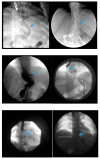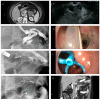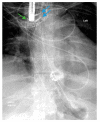Endoscopic Management of Post-Sleeve Gastrectomy Complications
- PMID: 38610776
- PMCID: PMC11012813
- DOI: 10.3390/jcm13072011
Endoscopic Management of Post-Sleeve Gastrectomy Complications
Abstract
Obesity is associated with several chronic conditions including diabetes, cardiovascular disease, and metabolic dysfunction-associated steatotic liver disease and malignancy. Bariatric surgery, most commonly Roux-en-Y gastric bypass and sleeve gastrectomy, is an effective treatment modality for obesity and can improve associated comorbidities. Over the last 20 years, there has been an increase in the rate of bariatric surgeries associated with the growing obesity epidemic. Sleeve gastrectomy is the most widely performed bariatric surgery currently, and while it serves as a durable option for some patients, it is important to note that several complications, including sleeve leak, stenosis, chronic fistula, gastrointestinal hemorrhage, and gastroesophageal reflux disease, may occur. Endoscopic methods to manage post-sleeve gastrectomy complications are often considered due to the risks associated with a reoperation, and endoscopy plays a significant role in the diagnosis and management of post-sleeve gastrectomy complications. We perform a detailed review of the current endoscopic management of post-sleeve gastrectomy complications.
Keywords: complications; endoscopic; endoscopy; fistula; gastrectomy; gastric; leak; management; sleeve; stenosis.
Conflict of interest statement
The authors declare no conflict of interest.
Figures










References
-
- Clapp B., Ponce J., DeMaria E., Ghanem O., Hutter M., Kothari S., LaMasters T., Kurian M., English W. American Society for Metabolic and Bariatric Surgery 2020 estimate of metabolic and bariatric procedures performed in the United States. Surg Obes. Relat. Dis. 2022;18:1134–1140. doi: 10.1016/j.soard.2022.06.284. - DOI - PubMed
Publication types
LinkOut - more resources
Full Text Sources
Research Materials

